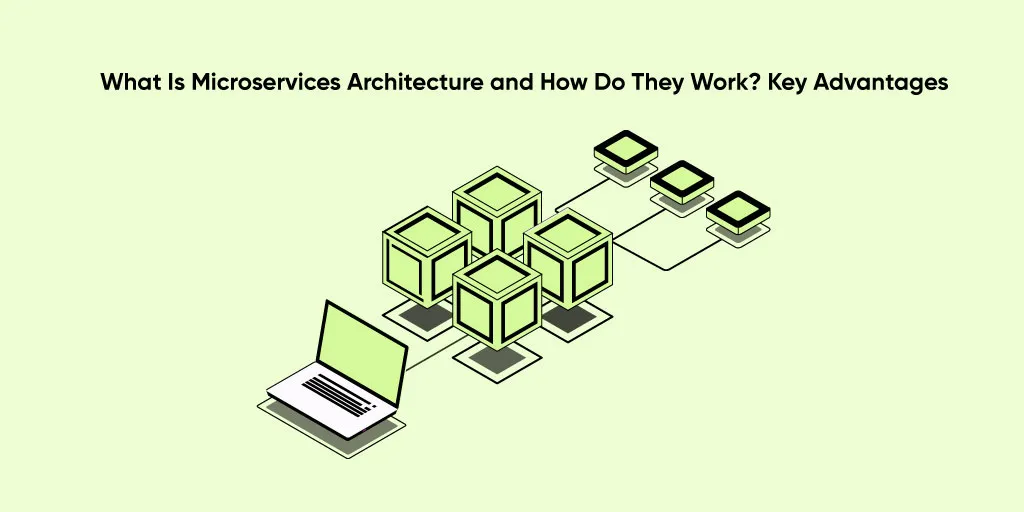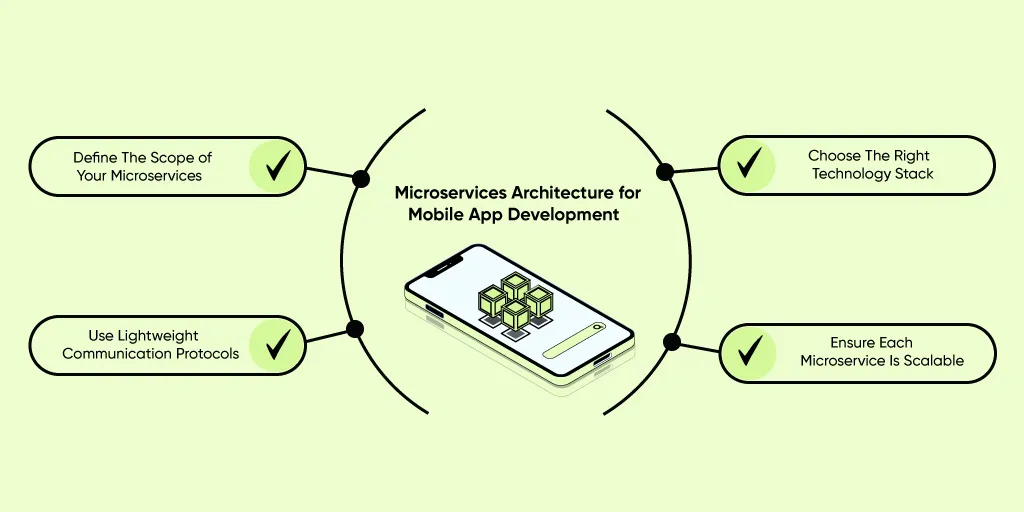Technology

9 min

Adopting the right architectural approach can make or break your project's success. One approach that has gained significant popularity in recent years is microservices architecture. This blog summarizes the best practices for implementing microservices architecture in mobile app development to help you build scalable, resilient, and efficient mobile applications.

By Dhruv Joshi
03 Nov, 2023
With the surge in mobile app usage, app developers, startups, and large corporations increasingly opt for microservices architecture for app development, which provides scalable, modular, and easily maintainable mobile applications. This approach involves breaking down large, complex, monolithic applications into smaller, self-contained services that can be developed, deployed and maintained independently.
The architecture for mobile app development has proven to be an effective software development methodology for building robust, agile mobile apps that can quickly adapt to changing market needs.
In this blog post, we will discuss microservice architecture principles for app development, best practices for building a microservices architecture for mobile app development, and some case studies to demonstrate how successful companies have implemented this approach.
Let's get started!
 Microservices architecture is a modern way of developing software that focuses on creating small, independent services that work together to form a complete application. Each service has a precise business function in this approach, sending and receiving data with other services through APIs.
Microservices architecture is a modern way of developing software that focuses on creating small, independent services that work together to form a complete application. Each service has a precise business function in this approach, sending and receiving data with other services through APIs.
This design provides greater flexibility and scalability in software development, allowing developers to quickly adapt to evolving requirements and scale applications to meet changing demands. A microservices architecture makes applications more resilient and reliable and can be developed and deployed more rapidly than traditional monolithic architecture.
In a microservices architecture for app development, services are usually developed and deployed independently, which makes updating and maintaining specific application components easier. This approach also allows individual services to be scaled horizontally, providing greater flexibility and more efficient resource utilization.
Microservices architecture relies heavily on communication protocols and API design to ensure that each service can communicate with other services in the system. Typically, RESTful APIs or message queues facilitate communication between services.
Also, microservices architecture often utilizes containerization technologies like Docker to package each service and its dependencies into a separate container, ensuring consistency and portability across different environments.
The Microservices architecture approach has some critical advantages over traditional rigid architectures.
Let's have a look!
Microservices architecture is a popular approach for app development that offers several benefits, including scalability. It can be challenging to scale the entire application with monolithic architectures because all components are tightly coupled. It means that any changes made to one component can have a ripple effect throughout the whole application. However, with the microservices architecture for app development, each service can be scaled independently, allowing developers to allocate resources more efficiently.
It also means that services can be replicated to handle increased traffic or user demand, making it a highly scalable architecture for app development.

By breaking down an application into more minor, independent services, developers can work on each service separately, making it easier to maintain and update the application. This approach also allows for greater flexibility and agility, as individual services can be updated or replaced without affecting other application parts. The modularity enables developers to make changes without disrupting the entire application, making it an ideal microservices architecture for app development.
Microservices architecture can also improve the reliability of an application. In a monolithic architecture, a single point of failure can cause the entire application to fail. With microservices, if one service fails, it does not necessarily affect the whole application. Additionally, because each service is designed to be independent, it can be tested and deployed separately, dropping the risk of errors and increasing overall reliability.
Another advantage of microservices architecture is the ease of deployment. Because each service is independent, it can be deployed separately without requiring a full application deployment. This approach allows for more frequent deployments and faster time-to-market.
A microservices architecture also allows for greater technology diversity. With monolithic architectures, all components are built using the same technology stack. With microservices, each service can be made using the technology best suited for its specific function. This approach can lead to incredible innovation and flexibility, as developers can experiment with new technologies without affecting the entire application.

The first step in building a microservices Architecture for Mobile App Development is to define the scope of your microservices. It means identifying the boundaries of your microservices and what functionality each microservice will provide. It's essential to keep each microservice focused on a specific business function to remain modular and can be developed, deployed, and maintained independently.
Microservices interconnect or communicate with each other through APIs, so it's important to use lightweight communication protocols like HTTP or RESTful APIs. These protocols are simple and easy to use, making it easier for developers to build and maintain microservices. Using lightweight communication protocols also reduces communication overhead between microservices, making the overall system faster and more efficient.
Choosing the right technology stack for your microservices architecture is critical. You want to select technologies that are easy to use, scalable, and reliable. Some popular technology stacks for building microservices include Java, Node.js, and Go. Choosing technologies well-suited to your mobile app's requirements and your development team's skills and experience is essential.
One of the primary advantages of microservices architecture is its ability to enable horizontal scaling, allowing for separate individual services. To ensure that each microservice is scalable, it is recommended to design each service to be stateless and independent, meaning that each service can be easily replicated to handle increased traffic without impacting other services within the system.
A service discovery mechanism is used to locate and connect to the various microservices in a system. Many tools are available for implementing service discovery, such as Consul, ZooKeeper, etcd. A service discovery mechanism is critical for ensuring your microservices can communicate, and the system can be easily scaled.
 Building a microservices architecture for a mobile app involves breaking down the app into more minor, separate services that can be developed, deployed, and scaled separately. Here are the steps to build a microservices architecture for a mobile app:
Building a microservices architecture for a mobile app involves breaking down the app into more minor, separate services that can be developed, deployed, and scaled separately. Here are the steps to build a microservices architecture for a mobile app:
(1.) Define the Services
Determine the services required for the app and how they will interact with each other. For example, a mobile e-commerce app may have services for user authentication, product search, product recommendations, and order processing.
(2.) Choose a Technology Stack
Choose a technology stack that is suitable for your app's requirements. This may include programming languages, frameworks, databases, and deployment tools.
(3.) Develop the Services
Develop each service independently, using the chosen technology stack. Each service should have its code repository and build a pipeline.
(4.) Define API Contracts
Define API contracts for each service, which specify the inputs and outputs of the service and how other services can access it.
(5.) Implement API Gateways
Implement API gateways for each service, which act as a front-end for the service and route requests to the appropriate service. The API gateways can also perform authentication, rate limiting, and other functions.
(6.) Deploy the Services
Deploy each service to a container or a serverless environment. Use a container orchestration tool like Kubernetes to deploy and scale the services.
(7.) Test the Services
Test each service independently, using the unit, integration, and end-to-end tests. Use a testing framework like Jest or Mocha to automate the testing process.
(8.) Monitor the Services
Monitor the performance and availability of each service using tools such as Prometheus and Grafana. Log aggregation tools such as ELK stack monitor logs and diagnose issues.
If we want to add a user authentication service in our microservices architecture mobile app, then we must do a separate service to add it. Here is a step-by-step sample code.
Here's a sample code for a user authentication service:-
const express = require('express');
const app = express();
const bodyParser = require('body-parser');
const jwt = require('jsonwebtoken');
app.use(bodyParser.json());
const users = [
{ username: 'user1', password: 'password1' },
{ username: 'user2', password: 'password2' }
];
app.post('/login', (req, res) => {
const { username, password } = req.body;
const user = users.find(u => u.username === username && u.password === password);
if (!user) {
return res.status(401).json({ message: 'Invalid username or password' });
}
const token = jwt.sign({ username }, 'secret');
res.json({ token });
});
app.get('/profile', (req, res) => {
const authHeader = req.headers['authorization'];
const token = authHeader && authHeader.split(' ')[1];
if (!token) {
return res.status(401).json({ message: 'No token provided' });
}
try {
const decoded = jwt.verify(token, 'secret');
res.json({ username: decoded.username });
} catch (error) {
res.status(401).json({ message: 'Invalid token' });
}
});
app.listen(3000, () => console.log('Authentication service started on port 3000'));
The above code is an example of an authentication service in Node.js using the Express framework, which allows users to log in and access a protected profile page. The service uses JSON Web Tokens (JWT) to authenticate requests.
Also, the whole service of user authentication can be breakdown into each service like:
Authentication service: This service handles login requests and issues JWT tokens. It would have the login route and communicate with a user service to authenticate the user's credentials.
User service: This service is responsible for storing and managing user data. It would receive requests from the authentication service to authenticate users and have routes for creating, updating, and deleting user data.
Profile service: This service retrieves user profile data. It would have the /profile route and would require a valid JWT token to access. It would communicate with the authentication service to verify the token and retrieve the user's profile data from the user service.
API gateway: This service would sit before the other services and act as a single entry point for external clients. It would receive all incoming requests and route them to the appropriate service. It also handles authentication and authorization, verifying JWT tokens and ensuring only authorized users can access protected routes.
Service discovery and registry: This service would keep track of all the deployed services and their locations on the network. It would allow other services to discover and communicate with each other without hardcoding IP addresses or ports.

Here are the top case studies of the top famous companies worldwide.
Netflix is a prime example of a company that has effectively leveraged microservices architecture for mobile app development. The company has an extensive suite of microservices that support its streaming platform, including services for video encoding, user data management, and content recommendation.
Netflix's mobile app is built on top of these microservices, allowing the company to deliver a seamless streaming experience to users. The app also uses containers to isolate individual services, ensuring that issues or bugs do not impact the entire system.
Amazon, the e-commerce giant, has used microservices architecture for mobile app development across various products and services. For example, the company's mobile shopping app is built on top of a suite of microservices that handle everything from product search to checkout.
One of the benefits of Amazon's microservices architecture is its ability to support rapid development and deployment. The company can quickly spin up new services as needed, and its mobile app is designed to seamlessly integrate with these services to deliver a fast and reliable shopping experience.
Uber is another company that has embraced microservices architecture for mobile app development. The company's app is built on top of a suite of microservices that handle everything from ride requests to payment processing.
One of the key advantages of Uber's microservices architecture is its scalability. The company can quickly and easily add new services to its platform to meet growing demand without rebuilding its entire system from scratch.
Spotify is the music streaming service, has also leveraged microservices architecture for its mobile app development. The app is built on microservices that handle everything from music playback to user data management.
One of the advantages of Spotify's microservices architecture is its ability to support personalization. The company's app is designed to leverage user data to deliver personalized music recommendations and playlists, all powered by its suite of microservices.
Airbnb, the popular online marketplace for short-term lodging, has also leveraged microservices architecture for mobile app development. The company's app is built on a series of microservices that handle everything from booking requests to payment processing.
One of the advantages of Airbnb's microservices architecture is its ability to support multiple platforms. The company's app is available on iOS and Android, as well as on the web, and its microservices are designed to work seamlessly across all these platforms.
The Guardian, the UK-based news organization, has used microservices architecture for its mobile app development. The app is built on top of a suite of microservices that handle everything from content delivery to user authentication.
One of the benefits of The Guardian's microservices architecture is its ability to support dynamic content. The company's app is designed to deliver real-time news updates and personalized content recommendations, all powered by its suite of microservices.
In conclusion, building a microservices Architecture for Mobile App Development offers several advantages: scalability, modularity, reliability, ease of deployment, and technology diversity. To successfully implement this approach, it's crucial to define your microservices' scope, use lightweight communication protocols, choose the right technology stack, ensure each microservice is scalable, and implement a service discovery mechanism.
By applying these best practices, you can create a scalable, modular, and easily maintainable mobile application that can quickly adapt to rapidly changing market needs.
If you're interested in building a microservices architecture for your mobile app, contact Quokka Labs, the reliable mobile app development company that can help you implement this approach effectively.
How Can Quokka Labs Help Me Build a Microservices Architecture for My Mobile App?
Quokka Labs can help you build a microservices architecture for your mobile app by providing expert consultation and development services. Our team of professional and highly experienced developers can help you design and implement a microservices architecture that is scalable, flexible, and easy to maintain.
What are characteristics of components in a microservice architecture?
Components in a microservices architecture are decoupled, independently deployable, communicate through APIs, focused on specific business capabilities, and can be developed, deployed, and scaled independently, promoting modularity and flexibility.
Why Use a Microservices Architecture for Mobile App Development?
Microservices architecture allows for the development of complex and scalable mobile applications that can be easily maintained. It also allows for quicker development and deployment of new features and provides greater flexibility and scalability.
What are microservices architecture patterns?
Microservices architecture patterns include Service Registry, API Gateway, Circuit Breaker, Saga Pattern, Event Sourcing, and CQRS.
How does a microservice architecture work?
Microservice architecture divides complex applications into smaller, independent services that communicate via APIs, enabling flexibility, scalability, and easier maintenance.
How to build a microservices architecture?
To build a microservices architecture, start by identifying service boundaries, choosing appropriate technologies, establishing communication protocols, and ensuring proper monitoring and orchestration for seamless integration and deployment.
How to design microservices architecture?
Designing a microservices architecture involves defining clear service interfaces, ensuring data consistency, implementing fault tolerance, utilizing containerization and orchestration tools, and prioritizing communication and collaboration among teams for effective development and deployment.
What is service-oriented architecture vs microservices?
Service-Oriented Architecture (SOA) is a broad architectural pattern focusing on service reusability and interoperability, often using standardized protocols, while microservices is a specific approach where applications are broken down into small, independent services that communicate through APIs, providing flexibility and scalability.
What is monolithic architecture vs microservices?
Monolithic architecture refers to a unified software structure where all components are tightly integrated, while microservices architecture divides the application into small, independent services that communicate via APIs, providing flexibility, scalability, and easier maintenance.
How to Develop a Web App: Step-by-Step Guide from Idea to Launch
By Sannidhya Sharma
5 min read
Top 11 Must-Have Features of a Custom Web Application in 2026
By Dhruv Joshi
5 min read
Generative AI Tech Stacks: Choosing the Right Tools for Scalable AI Development
By Dhruv Joshi
5 min read
Choosing Best Tech Stack for Web App Development: Performance, Cost, and Scalability
By Dhruv Joshi
5 min read

Technology

7 min
Generative AI is moving fast into enterprises, from banks to hospitals to government agencies. Adoption is rapid, but security planning lags. Unlike traditional systems, these models can be exploited through prompt injection, poisoned data, or manipulated to leak sensitive information. They are also misused for phishing, deepfakes, and malicious code.


Technology

7 min
AI-powered Web Application Firewalls (WAFs) go beyond static rules by using machine learning, anomaly detection, and predictive analysis to block zero-day threats, reduce false positives, and protect APIs at scale. Unlike traditional WAFs, they self-learn, adapt in real time, and cut operational costs while improving compliance and trust.


Technology

5 min
AI is redefining mobile app security by transforming how threats are detected, tested, and prevented. From continuous monitoring and fraud detection to compliance with regulations, AI ensures apps remain resilient against modern risks. This means safer apps, protected users, and stronger businesses. Investing in AI-driven security today builds trust, drives growth, and secures long-term competitive advantage.


Feeling lost!! Book a slot and get answers to all your industry-relevant doubts